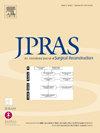COVID-19 与整形外科术后并发症:不仅仅是高凝状态
IF 2
3区 医学
Q2 SURGERY
Journal of Plastic Reconstructive and Aesthetic Surgery
Pub Date : 2024-09-12
DOI:10.1016/j.bjps.2024.09.024
引用次数: 0
摘要
背景虽然整形外科手术中静脉血栓栓塞症(VTE)的发生率一般低于 2%,但后 COVID 时代的数据仍然难以捉摸。本研究旨在阐明 COVID-19 感染与整形外科手术 VTE 结果风险之间的关系。方法在 2012-2022 年国家外科质量改进计划数据库中确定了整形外科手术。相关结果包括术后发生 VTE(定义为深静脉血栓形成(DVT)或肺栓塞(PE))和术后并发症。采用倾向得分匹配法:1)比较大流行前和大流行时期队列中 VTE 的总体发生率;2)比较 2021-2022 年诊断出和未诊断出 COVID-19 的病例中 VTE 的发生率和术后并发症的总体发生率(p < 0.05)。结果总计确定了 269,006 例整形外科病例,包括一般乳房(76%)和躯干(9.4%)手术。非乳房游离组织转移手术的深静脉血栓发生率最高(1.3%),躯干手术的PE发生率最高(0.7%)。经过倾向得分匹配后,COVID-19 大流行后的 VTE 总发生率与大流行前没有显著差异(p = 0.40)。结论虽然在匹配分析中 COVID-19 诊断本身并不能预测 VTE 的风险,但它能显著预测总体术后并发症。未来的研究可能会在更长的随访期内进一步调查 COVID-19 感染的影响。本文章由计算机程序翻译,如有差异,请以英文原文为准。
COVID-19 and postoperative complications after plastic surgery procedures: More than just hypercoagulability
Background
Although plastic surgery procedures generally demonstrate less than 2% incidence of venous thromboembolism (VTE) outcomes, the post-COVID era data remain elusive. This study sought to elucidate the relationship between COVID-19 infection and the risk of VTE outcomes across plastic surgery procedures.
Methods
Plastic surgery procedures were identified in the 2012–2022 National Surgical Quality Improvement Program databases. The outcomes of interest were the postoperative occurrence of VTE, defined as deep vein thrombosis (DVT) or pulmonary embolism (PE), and postoperative complication. Propensity score matching was used to 1) compare overall rates of VTE between the pre-pandemic era and pandemic era cohorts and 2) compare rates of VTE and overall postoperative complications in cases with and without COVID-19 diagnosis in the years 2021–2022 (p < 0.05).
Results
Overall, 269,006 plastic surgery cases were identified, comprising general breast (76%) and trunk (9.4%) procedures. Non-breast free tissue transfer cases were associated with the highest rates of DVT (1.3%) and trunk procedures with the highest rates of PE (0.7%). After propensity score matching, the overall rate of VTE after the onset of the COVID-19 pandemic was not significantly different from the pre-pandemic era (p = 0.40). In a separately matched cohort, COVID-19 diagnosis did not significantly predict the risk for VTE (p = 0.48) but did significantly predict the risk for overall postoperative complications (p < 0.001).
Conclusions
Although COVID-19 diagnosis itself did not predict the risk of VTE in matched analysis, it significantly predicted the overall postoperative complications. Future studies may further investigate the effects of COVID-19 infection over longer periods of follow-up.
求助全文
通过发布文献求助,成功后即可免费获取论文全文。
去求助
来源期刊
CiteScore
3.10
自引率
11.10%
发文量
578
审稿时长
3.5 months
期刊介绍:
JPRAS An International Journal of Surgical Reconstruction is one of the world''s leading international journals, covering all the reconstructive and aesthetic aspects of plastic surgery.
The journal presents the latest surgical procedures with audit and outcome studies of new and established techniques in plastic surgery including: cleft lip and palate and other heads and neck surgery, hand surgery, lower limb trauma, burns, skin cancer, breast surgery and aesthetic surgery.

 求助内容:
求助内容: 应助结果提醒方式:
应助结果提醒方式:


